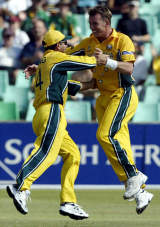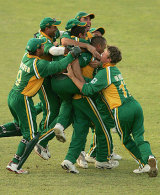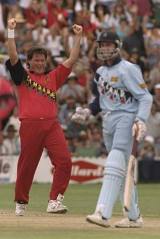Three-card trick
Andrew Miller and Martin Williamson on players who have taken one-day hat-tricks
Andrew Miller and Martin Williamson
17-Oct-2006
Jerome Taylor's match-clinching hat-trick against Australia last week was the 22nd time the feat had been achieved in one-day internationals. Here, Cricinfo takes a look at 11 of the most (or least) memorable men to have taken three wickets in three balls. The full list is here.
Brett Lee, Australia v Kenya, World Cup 2003
The eventual World Cup winners against the semi-finalists should have been a good contest, but in reality it was men against boys. With no decent national league, Kenya's batsmen were used to facing trundlers, not Brett Lee thunderbolts. As it was, he took wickets with his 10th, 11th and 12th balls to reduce them to 3 for 3 - he finished with 3 for 14 off eight overs. The first wicket - Kennedy Otieno - was a tad unlucky as it cannoned painfully off the batsman's elbow onto his stumps. The second was caught at third slip, while the last one, a searing yorker, ripped out David Obuya's off stump. Lee, however, did not get the Man-of-the-Match award (Ricky Ponting described the decision as "bemusing") - instead that went to 39-year-old Aasif Karim, who took 3 for 7 in 8.2 overs.
|
|

|
Click here to watch Vaas's World Cup hat-trick.
Chaminda Vaas, Sri Lanka v Zimbabwe 2001-02 and Bangladesh 2002-03
Chaminda Vaas recorded two one-day hat-tricks in the space of two-and-a-half years, and both came as part of some of the most spectacular carnage ever seen in an international cricket match. At Colombo in December 2001, Vaas struck with his first ball of the game and seven times thereafter, as Zimbabwe were sent hurtling to a humiliating 38 all out. Nobody had ever before taken so many wickets in a one-day innings, but Vaas might even have been on course for all ten. Instead Muttiah Muralitharan entered the attack in the 16th over, and struck twice in four balls to end the fun. Not content with one ODI record, Vaas soon racked up another, at Pietermaritzburg in the 2003 World Cup, when he removed three Bangladeshi batsmen - Hannan Sarkar, Mohammad Ashraful and Ehsanul Haque - with the first three balls of the match. Sanwar Hossain fell to the fifth ball of the same over, to send Sri Lanka galloping towards a ten-wicket win.
Chaminda Vaas recorded two one-day hat-tricks in the space of two-and-a-half years, and both came as part of some of the most spectacular carnage ever seen in an international cricket match. At Colombo in December 2001, Vaas struck with his first ball of the game and seven times thereafter, as Zimbabwe were sent hurtling to a humiliating 38 all out. Nobody had ever before taken so many wickets in a one-day innings, but Vaas might even have been on course for all ten. Instead Muttiah Muralitharan entered the attack in the 16th over, and struck twice in four balls to end the fun. Not content with one ODI record, Vaas soon racked up another, at Pietermaritzburg in the 2003 World Cup, when he removed three Bangladeshi batsmen - Hannan Sarkar, Mohammad Ashraful and Ehsanul Haque - with the first three balls of the match. Sanwar Hossain fell to the fifth ball of the same over, to send Sri Lanka galloping towards a ten-wicket win.
Click here to watch Vaas's World Cup hat-trick.
Wasim Akram, Pakistan v West Indies and Australia, Sharjah 1989-90
Wasim Akram, one of cricket's all-time greats, was at his absolute zenith at the start of the 1990s, as he demonstrated with two hat-tricks in the space of seven months between October 1989 and May 1990. Both feats were achieved at Pakistan's home-from-home at Sharjah, all six victims were bowled, and Pakistan emerged victorious on each occasion. Wasim's run began inauspiciously when he himself was trapped first-ball by Curtly Ambrose, but revenge was swift and comprehensive, as Ambrose became the third victim in an over that also included Jeff Dujon and Malcolm Marshall. West Indies had been cruising to victory on 209 for 5 needing 251 to win, but were bundled out for 239, with Wasim returning 5 for 38. His second hat-trick came in remarkably similar circumstances. Australia looking threatening on 230 for 7, needing 267 for victory in the final of the Austra-Asia Cup, but another lethal burst destroyed the tail and left Ian Healy (12 not out) high and dry.
Wasim Akram, one of cricket's all-time greats, was at his absolute zenith at the start of the 1990s, as he demonstrated with two hat-tricks in the space of seven months between October 1989 and May 1990. Both feats were achieved at Pakistan's home-from-home at Sharjah, all six victims were bowled, and Pakistan emerged victorious on each occasion. Wasim's run began inauspiciously when he himself was trapped first-ball by Curtly Ambrose, but revenge was swift and comprehensive, as Ambrose became the third victim in an over that also included Jeff Dujon and Malcolm Marshall. West Indies had been cruising to victory on 209 for 5 needing 251 to win, but were bundled out for 239, with Wasim returning 5 for 38. His second hat-trick came in remarkably similar circumstances. Australia looking threatening on 230 for 7, needing 267 for victory in the final of the Austra-Asia Cup, but another lethal burst destroyed the tail and left Ian Healy (12 not out) high and dry.
Kapil Dev, India v Sri Lanka, Asia Cup, 1990-91
In recent years, India have been none too special in one-day finals, with 15 defeats in their last 16 completed tournaments dating back to 1998-99. But it wasn't always thus, and in January 1991, Kapil Dev helped to add another piece of silverware to his country's trophy-room. The tournament in question was the grandly named Asia Cup, although Pakistan's absence on safety grounds did weaken the field somewhat. After dispatching of Bangladesh in the qualifying round, Sri Lanka were India's opponents and, in a match shortened by rain, Kapil wrecked the middle order with a hat-trick spread over two overs. Roshan Mahanama, Sanath Jayasuriya and Ravi Ratnayake were his victims as Sri Lanka tottered from 150 for 3 to 204 all out, and ultimately a seven-wicket defeat.
In recent years, India have been none too special in one-day finals, with 15 defeats in their last 16 completed tournaments dating back to 1998-99. But it wasn't always thus, and in January 1991, Kapil Dev helped to add another piece of silverware to his country's trophy-room. The tournament in question was the grandly named Asia Cup, although Pakistan's absence on safety grounds did weaken the field somewhat. After dispatching of Bangladesh in the qualifying round, Sri Lanka were India's opponents and, in a match shortened by rain, Kapil wrecked the middle order with a hat-trick spread over two overs. Roshan Mahanama, Sanath Jayasuriya and Ravi Ratnayake were his victims as Sri Lanka tottered from 150 for 3 to 204 all out, and ultimately a seven-wicket defeat.
Charl Langeveldt, West Indies v South Africa, Bridgetown, 2004-05
Rarely has a one-day series been clinched in such dramatic fashion. South Africa were 2-0 up in the five-match series, but West Indies seemed set to keep the rubber alive when they were left needing four runs to win with four wickets and seven balls remaining. But when Courtney Browne fell to the final ball of the penultimate over, panic set into the West Indian performance. Charl Langeveldt, the sort of wobbly under-rated seamer that has thrived so often in the Caribbean, was just the man to exploit the nerves. Ian Bradshaw and Dwayne Bravo swapped singles to leave West Indies needing two runs off four balls, but Langeveldt bowled Bradshaw with a perfect length delivery, before splattering Daren Powell's stumps with a replica delivery. Two off two with one man standing, then, but Corey Collymore was no match for a zoned bowler. Langeveldt produced a beautiful full inswinger that trapped him plumb lbw, and South Africa had stolen a remarkable victory.
|
|

|
Jalal-ud-Din, Pakistan v Australia, Lahore 1982-83
A right-arm fast-medium bowler who always played in glasses, Jalal-ud-Din played only a handful of Tests and one-dayers but eked out a place in cricket history when he took the first hat-trick in an ODI. He came on when Australia, well behind the clock in a 40-over match, were pushing for quick runs and he removed Rod Marsh, Bruce Yardley and Geoff Lawson to end the contest. His one-day record was good, but he played in an era when Test and ODI sides were pretty much considered one and the same, and so his failure in the longer game effectively scuppered his chances.
A right-arm fast-medium bowler who always played in glasses, Jalal-ud-Din played only a handful of Tests and one-dayers but eked out a place in cricket history when he took the first hat-trick in an ODI. He came on when Australia, well behind the clock in a 40-over match, were pushing for quick runs and he removed Rod Marsh, Bruce Yardley and Geoff Lawson to end the contest. His one-day record was good, but he played in an era when Test and ODI sides were pretty much considered one and the same, and so his failure in the longer game effectively scuppered his chances.
Saqlain Mushtaq, Pakistan v Zimbabwe, The Oval, 1999
Both of Saqlain's one-day hat-tricks came against Zimbabwe, and four of the six dismissals came with the help of Moin Khan (who had himself been the last victim in the previous ODI hat-trick, that of Anthony Stuart). At The Oval in a World Cup group match, Zimbabwe were already down and out when Saqlain struck in front of his home crowd (he was contracted to Surrey at the time). The first two batsmen - Henry Olonga and Adam Huckle - aimed massive heaves and were left stranded, leaving Moin to remove the bails, while Pommie Mbangwa, a genuine Test rabbit even by Zimbabwe standards, found himself surrounded by a ring of fielders for the hat-trick ball. At least he did not swing wildly, but was plumb lbw anyway.
Both of Saqlain's one-day hat-tricks came against Zimbabwe, and four of the six dismissals came with the help of Moin Khan (who had himself been the last victim in the previous ODI hat-trick, that of Anthony Stuart). At The Oval in a World Cup group match, Zimbabwe were already down and out when Saqlain struck in front of his home crowd (he was contracted to Surrey at the time). The first two batsmen - Henry Olonga and Adam Huckle - aimed massive heaves and were left stranded, leaving Moin to remove the bails, while Pommie Mbangwa, a genuine Test rabbit even by Zimbabwe standards, found himself surrounded by a ring of fielders for the hat-trick ball. At least he did not swing wildly, but was plumb lbw anyway.
|
|

|
The hat-trick that heralded a thousand headlines. On England's maiden Test tour of Zimbabwe, the British press were already gunning for their under-performing cricket team when Eddo Brandes - part-time seam bowler, full-time chicken farmer - burst out of the coop to send the feathers flying. David Lloyd's assertion that England had "flippin' murdered" Zimbabwe in the earlier (drawn) Test series came home to roost as England were routed 3-0 in the subsequent one-day series. Brandes's finest hour occurred in the third match, when England, chasing 250 for victory, slumped to a pitiful 118 all out. Nick Knight, John Crawley and Nasser Hussain were the hat-trick victims, and - in keeping with the poultry theme - there were further ducks for Ronnie Irani, Craig White and Chris Silverwood.
Aaqib Javed, Pakistan v India, Sharjah, 1991-92
Though he spent most of his career in the shadow of Waqar Younis and Wasim Akram, Aaqib Javed still had some memorable moments in the limelight, not least at Sharjah in October 1991. At 19 years and 81 days, he not only became the youngest man to take an ODI hat-trick, but also finished up with figures of 7 for 37 - the best in ODI history until Muralitharan (7 for 30) surpassed him nine years later. It was a pretty illustrious list of victims as well. All seven dismissals were in the top eight, while the hat-trick consisted of a trio of lbws. Ravi Shastri, Mohammad Azharuddin and Sachin Tendulkar, all of whom attempted to play across the line and paid the price. Not a bad effort for a teenager.
Though he spent most of his career in the shadow of Waqar Younis and Wasim Akram, Aaqib Javed still had some memorable moments in the limelight, not least at Sharjah in October 1991. At 19 years and 81 days, he not only became the youngest man to take an ODI hat-trick, but also finished up with figures of 7 for 37 - the best in ODI history until Muralitharan (7 for 30) surpassed him nine years later. It was a pretty illustrious list of victims as well. All seven dismissals were in the top eight, while the hat-trick consisted of a trio of lbws. Ravi Shastri, Mohammad Azharuddin and Sachin Tendulkar, all of whom attempted to play across the line and paid the price. Not a bad effort for a teenager.
Anthony Stuart, Australia v Pakistan, Melbourne, 1996-97
Anthony Who? Only family members and quiz fanatics will recall the international career of the New South Welshman, Anthony Stuart, who came, excelled, and vanished in the space of 11 heady days. The journey began at Brisbane on January 5, 1997, when injuries to Glenn McGrath, Paul Reiffel and Jason Gillespie meant that Australia's new ball was placed in the hands of two debutants, Stuart and Andy Bichel. And it ended at Melbourne after just three matches, thanks in no small part to Australia's rare failure to qualify for the final of their own one-day tournament. But Stuart bowed out on a high nonetheless. In front of a crowd of 48,000, he dismissed Ijaz Ahmed, Mohammad Wasim and Moin Khan to set up a consolation win for a disconsolate team, but there was no time left that season to capitalise on his success. He was overlooked for Australia's Ashes squad, and rapidly faded from view.
Anthony Who? Only family members and quiz fanatics will recall the international career of the New South Welshman, Anthony Stuart, who came, excelled, and vanished in the space of 11 heady days. The journey began at Brisbane on January 5, 1997, when injuries to Glenn McGrath, Paul Reiffel and Jason Gillespie meant that Australia's new ball was placed in the hands of two debutants, Stuart and Andy Bichel. And it ended at Melbourne after just three matches, thanks in no small part to Australia's rare failure to qualify for the final of their own one-day tournament. But Stuart bowed out on a high nonetheless. In front of a crowd of 48,000, he dismissed Ijaz Ahmed, Mohammad Wasim and Moin Khan to set up a consolation win for a disconsolate team, but there was no time left that season to capitalise on his success. He was overlooked for Australia's Ashes squad, and rapidly faded from view.
James Anderson, England v Pakistan, The Oval, 2003
In the summer of 2003, James Anderson could do no wrong. The new pin-up of English cricket had burst onto the scene in Australia the previous winter, before cementing his place in the nation's affections with a superlative World Cup display against Pakistan at Cape Town. He went on to make his Test debut against Zimbabwe and took five wickets at the first attempt, and so it was only a matter of time before he added a hat-trick as well. Lo and behold, it came to pass at The Oval, when he struck with his first ball of the match and cleaned up with his last three. If the first victim was slightly fortunate - Abdul Razzaq slapped a half-tracker to mid-off - the second two were absolute jaffas, in particular the decisive full-length outswinger that demolished Mohammad Sami's stumps. He would learn about the hard times soon enough, but at this stage Anderson really was the David Beckham of cricket.
In the summer of 2003, James Anderson could do no wrong. The new pin-up of English cricket had burst onto the scene in Australia the previous winter, before cementing his place in the nation's affections with a superlative World Cup display against Pakistan at Cape Town. He went on to make his Test debut against Zimbabwe and took five wickets at the first attempt, and so it was only a matter of time before he added a hat-trick as well. Lo and behold, it came to pass at The Oval, when he struck with his first ball of the match and cleaned up with his last three. If the first victim was slightly fortunate - Abdul Razzaq slapped a half-tracker to mid-off - the second two were absolute jaffas, in particular the decisive full-length outswinger that demolished Mohammad Sami's stumps. He would learn about the hard times soon enough, but at this stage Anderson really was the David Beckham of cricket.
Andrew Miller is UK editor of Cricinfo